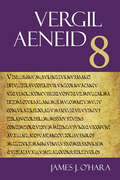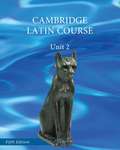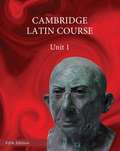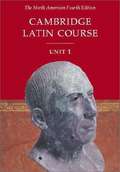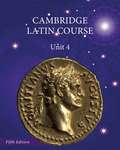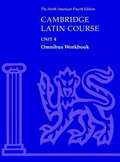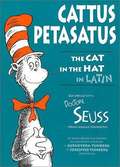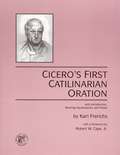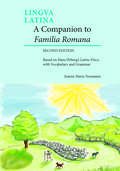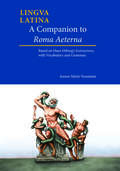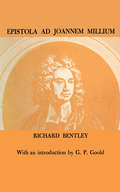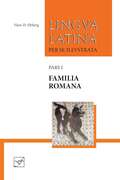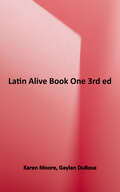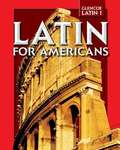- Table View
- List View
Aeneid 8 (The Focus Vergil Aeneid Commentaries)
by Vergil Mr James J. O'Hara Randall GanibanVergil: Aeneid 8 is part of a new series of commentaries on the Aeneid. Each volume adapts with extensive revisions and additions the commentaries of T. E. Page (1884, 1900), and is edited by a scholar of Roman epic. The present volume offers the Latin text of Book 8 along with maps, extensive notes, and commentary designed to meet the needs of intermediate students of Latin. A two-volume edition of the entire Aeneid designed to meet the needs of advanced students will be derived from the series.
Caesar: Selections From His Commentarii De Bello Gallico
by Hans-Friedrich Mueller Julius Caesar Donald E. Sprague Bridget S. DeanNIMAC-sourced textbook
Cambridge Latin Course (North American Cambridge Latin Course Ser. #Unit 2)
by Cambridge University PressNIMAC-sourced textbook
Cambridge Latin Course (North American Cambridge Latin Course Ser. #Unit 1)
by Cambridge University PressNIMAC-sourced textbook
Cambridge Latin Course, Unit 1
by Stephanie M. Pope Patricia E. Bell Stan Farrow Anne Shaw Randy Thompson Joy Mellor Leslie Jones Peter Kesteven Neil SuttonThe Fourth Edition Cambridge Latin Course is an introductory program organized into four well-integrated units. Cambridge's proven approach includes a stimulating continuous story line, interwoven grammatical development and cultural information, supportive illustrations and photographs, and a complete Language Information section. Reading is the heart of the Cambridge Latin Course, and all the elements of the program - illustrations, vocabulary, grammar and syntax, cultural contexts and references, activities - are carefully introduced and arranged to provide students with the skills they need to read with comprehension and enjoyment from the very first page.
Cambridge Latin Course, Unit 4
Developed by the University of Cambridge School Classics Project, this bestselling Latin program provides an enjoyable and carefully paced introduction to the Latin language, complemented by background information on Roman culture and civilization. In the first half of Unit 4, the story reaches its climax and final denouement in and around the court of the Emperor Domitian. There follows a selection of original texts by Roman authors (adapted where necessary), including Catullus, Ovid, Pliny, Tacitus, and Virgil.
Cambridge Latin Course, Unit 4, Omnibus Workbook
by Stephanie M. Pope Patricia E. Bell Stan Farrow Richard M. Popeck Anne Shaw Joy Mellor Leslie Jones Peter Kesteven Neil SuttonThe North American Cambridge Latin Course is a well-established four-part Latin program whose approach combines a stimulating, continuous storyline with grammatical development, work on derivatives, and cultural information. There is also a complete Language Information section, plus numerous color photographs illustrating life in the Roman world. The Course has now been fully revised and updated in light of feedback from user schools, and includes the very best in new research. The Fourth Edition continues to offer teachers and students alike a stimulating, reading-based approach to the study of Latin. The Omnibus Workbook is designed to be used in conjunction with the Unit 4 Student's Text. A variety of exercises is provided for each Stage.
Cattus Petasatus: The Cat in the Hat in Latin
by Jennifer Morrish Tunberg Terence Tunberg SeussIncludes a Latin-English glossary and a note on the verse form and rhythm.
Cicero: Pro Archia Poeta Oratio (Annotated Latin Collection)
by Steven M. Cerutti Cicero Gaby HuebnerNIMAC-sourced textbook
Cicero's First Catilinarian Oration with Introduction, Running Vocabularies, and Notes
by Karl Frerichs Marcus Tullius Cicero Laurie Haight KeenanCicero's First Catilinarian speech is now available in a practical and inexpensive annotated edition for third-year Latin students. In light of existing textbooks, Karl Frerichs' edition has several important and distinguishing strengths: -- Clear, tripartite page layout for text, vocabulary and notes on facing pages-- Running vocabulary separate from notes and complete vocabulary at the end-- Introduction and Glossary of Terms and Figures of Speech provide basic biographical, historical, and rhetorical background-- Maps and illustrations
A Companion to Familia Romana: Based on Hans Ørberg's Latine Disco, with Vocabulary and Grammar
by Jeanne Neumann Hans H. ØrbergThis volume is the completely reset Second Edition of Jeanne Marie Neumann's A College Companion (Focus, 2008). It offers a running exposition, in English, of the Latin grammar covered in Hans H. Ørberg's Familia Romana, and includes the complete text of the Ørberg ancillaries Grammatica Latina and Latin–English Vocabulary. It also serves as a substitute for Ørberg's Latine Disco, on which it is based. As it includes no exercises, however, it is not a substitute for the Ørberg ancillary Exercitia Latina I. Though designed especially for those approaching Familia Romana at an accelerated pace, this volume will be useful to anyone seeking an explicit layout of Familia Romana's inductively-presented grammar. In addition to many revisions of the text, the Second Edition also includes new units on cultural context, tied to the narrative content of the chapter.
A Companion to Roma Aeterna: Based on Hans Ørberg's Instructions, with Vocabulary and Grammar
by Jeanne Neumann Hans H. ØrbergA sequel to her widely used A Companion to Familia Romana (now in its second edition), Jeanne Marie Neumann's A Companion to Roma Aeterna offers a running commentary, in English, of the Latin grammar covered in Hans H. Ørberg's Roma Aeterna, and includes the complete text of the Ørberg ancillaries Grammatica Latina and Latin–English Vocabulary II. It also serves as a substitute for Ørberg’s Instructions, on which it is based. Though designed especially for those approaching Roma Aeterna at an accelerated pace, this volume will be useful to anyone seeking an explicit exposition of that volume's implicitly presented grammar. In addition to many revisions of the text, A Companion to Roma Aeterna also includes new units on cultural context, tied to the narrative content of the chapter.
Epistola ad Joannem Millium
by Richard Bentley G. P. GooldThe year 1962 marks the tercentenary of the birth of Richard Bentley (1662-1742), Master of Trinity College, Cambridge, editor of Paradise Lost, but principally and justly famous as one of the greatest classical scholars. To mark the event, the University of Toronto Press is issuing a special reprint of Alexander Dyce's edition of the Epistola (1691), the work which first brought Bentley fame, and which has long been out of print.<P><P>This Latin exercise was called forth by one of those unhappy productions which, mediocre themselves, have had the ill luck to attract the inspection of genius. In the eighth or ninth century A.D., Joannes Malelas of Antioch, a Greek writer, attempted a chronological record of mankind and in it he had recourse to name or quote from classical works no longer extant. English scholars in the seventeenth century prepared a translation of the chronicle into Latin and an accompanying commentary; just before its publication, under the final editorship of John Mill, Bentley was given an opportunity to read proof-sheets and the result was the Epistola, a collection mainly of some twenty-five notes upon statements found in or topics suggested by Malelas. <P>This extraordinary performance by a scholar of 29 moves from one topic to another over a wide range of ancient literature, explaining or correcting some sixty Greek and Latin authors. The notes are not so much a commentary on the old chronicler as a set of dazzling dissertations pegged upon a random set of appalling howlers, and they reveal prodigious information and gift of divination. Bentley's style in Latin is clear and spirited and seasoned with choice of quotation. <P>The Epistola immediately secured for its writer the fame reserved for men of the rarest excellence and this classic among academic productions is still charged with power to instruct and inspire the scholarship of another era.
Familia Romana (Lingua Latina #Book One)
by Hans H. ØrbergHans Ørberg's Lingua Latina per se Illustrata is the world's premiere series for learning Latin via the Natural Method. The Natural Method encourages students to learn Latin without resorting to translation, but instead by teaching them to think in the language: students first learn grammar and vocabulary inductively through extended contextual reading and an ingenious system of marginal notes. Lingua Latina per se Illustrata is also the most popular series for those teachers at both the secondary and collegiate levels who wish to develop Latin conversational skills in the classroom. <p><p>Familia Romana (the main book of Pars I of the Lingua Latina per se illustrata series) contains thirty-five chapters and describes the life of a Roman family in the 2nd century A.D. It culminates in readings from classical poets and Donatus's Ars Grammatica, the standard Latin school text for a millennium. Each chapter is divided into two or three lessons (lectiones) of a few pages each followed by a grammar section (Grammatica Latina) and three exercises (Pensa). Hans Ørberg's impeccable Latin, humorous stories, and the Peer Lauritzen illustrations, reproduced in full color, make this work a classic. The book also includes a table of declensions, a Roman calendar, and a word index (index vocabulorum). <p><p>The Lingua Latina series incorporates the following features: <p><p>The most comprehensive treatment of Latin grammar available in an elementary textbook. <p><p>A vocabulary of almost 1,800 words, reinforced by constant and creatively phrased repetition, vastly expands the potential for later sight reading. <p><p>A complete line of ancillary volumes, exercises, and readers both in print and online.
Latin Alive! (Latin Alive Series #Book One)
by Karen Moore Gaylan DuBoseStudents will be delighted by what they learn in each new chapter of Latin Alive!, Book One, and they will learn to see that Latin is everywhere around them. As the first text in a three-year series, it is a rigorous and thorough introduction to this great language and is designed to engage upper school (middle and high school) student. Brimming with relevant facts and stories this text offers something for everyone. A Teacher’s Edition including answer keys, teacher’s helps and additional activities is available separately.

